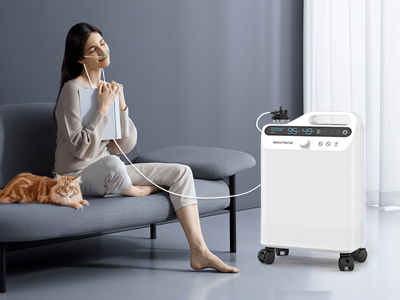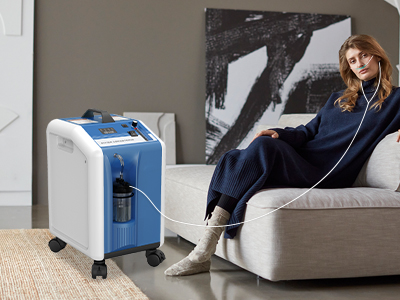21 May 2024
Planning a holiday can be exhilarating. However, for those requiring an oxygen concentrator, meticulous preparation is paramount. Ensuring that every aspect of the journey is well thought out guarantees not only a safe trip but also a relaxing and enjoyable experience.
Traveling with an oxygen concentrator presents unique challenges. From ensuring the device's portability to understanding different transportation providers' policies, every step requires careful attention. These challenges, though daunting, are manageable with the right strategies.

Choosing the Right Oxygen Concentrator for Travel
A. Portable vs. Stationary Oxyen Machine
concentrators are designed for mobility, providing the flexibility to move freely. They are lightweight and compact, making them ideal for travel. Stationary oxygen concentrators, on the other hand, are bulkier but offer higher oxygen outputs.
B. Battery Life and Charging Options
Battery life is a critical factor. Portable oxygen concentrators come with varying battery capacities, and it's essential to choose one that can last through long flights or bus rides. Additionally, consider the availability of charging options, such as car adapters and extra batteries.
C. Size and Weight Considerations
The size and weight of the concentrator should align with the traveler's physical capabilities and the trip's logistics. Compact and lightweight models are easier to carry and store, reducing the physical strain on the traveler.
Preparing for Air Travel
A. Airline Policies and Requirements
Different airlines have specific policies regarding oxygen concentrators. It's essential to contact the airline well in advance to understand their requirements. Documentation from a healthcare provider and advance notice to the airline are often necessary.
B. Security Screening Procedures
Security screening can be a hassle. Be prepared to explain the device's function and present any necessary medical documentation. The Transportation Security Administration (TSA) has guidelines for medical devices, which can help streamline the process.
C. In-Flight Oxygen Needsy
Arranging in-flight oxygen is another consideration. Some airlines provide oxygen, while others may allow personal concentrators. Ensure the device is approved for in-flight use and understand the procedures for operating it during the flight.
Traveling by Train or Bus
A. Checking with Transport Providers
Before embarking on a train or bus journey, check with the transport providers about their policies on oxygen concentrators. Understanding these policies helps avoid last-minute surprises and ensures a smoother journey.
B. Power Supply Availability
Access to power outlets is crucial for longer trips. Confirm whether the train or bus has power supplies available for passengers to use. Bringing extra batteries as a backup is always a wise decision.
C. Space and Comfort Concerns
Traveling by train or bus means managing space constraints. Choose a seat with ample space to accommodate the concentrator comfortably. Prioritize comfort and accessibility when making reservations.

Road Trips with an Oxygen Concentrator
A. Vehicle Adaptations
For road trips, the vehicle may need adaptations to ensure the concentrator operates smoothly. This includes securing the device safely and having a car adapter to charge it while driving.
B. Planning Rest Stops
Plan frequent rest stops to stretch, hydrate, and check the concentrator's battery levels. These breaks also provide an opportunity to ensure the device is functioning correctly and to address any issues promptly.
C. Emergency Preparedness
Prepare for emergencies by carrying contact numbers for healthcare providers, extra batteries, and a portable charger. Knowing the locations of nearby hospitals along the route adds an extra layer of security.
Accommodation Arrangements
A. Hotel Accessibility
When booking accommodations, verify the hotel's accessibility. Ensure that the room has sufficient space and amenities to accommodate the oxygen concentrator and its requirements.
B. Ensuring Power Outlets
Confirm that the hotel room has enough power outlets. Bringing a power strip can be beneficial, especially if multiple devices need charging.
C. Special Requests and Services
Inform the hotel staff of any special requirements. This can include requesting a ground-floor room for easier access or notifying them about the need for additional power supplies.
Packing Essentials
A. Medical Documentation
Carry all necessary medical documentation, including prescriptions, a letter from a healthcare provider, and a list of medications. These documents are crucial for both travel and any potential medical emergencies.
B. Extra Supplies and Accessories
Pack extra supplies such as cannulas, tubing, and batteries. Having spare parts ensures that the trip isn't disrupted by equipment failures.
C. Maintenance Tools
Bring tools for maintaining the oxygen concentrator, such as cleaning supplies and user manuals. Regular maintenance ensures the device remains in optimal condition throughout the journey.
Staying Safe and Comfortable
A. Managing Oxygen Levels
Monitor oxygen levels regularly to ensure the oxygen concentrator is delivering the required amount. Adjust the settings as needed and consult with a healthcare provider if any issues arise.
B. Staying Hydrated and Healthy
Staying hydrated and maintaining overall health is vital. Drink plenty of fluids, eat balanced meals, and rest adequately to avoid complications.
C. Dealing with Unforeseen Issues
Be prepared to deal with unforeseen issues, such as device malfunctions or health concerns. Having a contingency plan and knowing who to contact in case of emergencies can alleviate stress.
Tips for Enjoying Your Holiday
A. Pacing Yourself
Pace yourself to avoid overexertion. Plan activities that match your energy levels and take breaks as needed.
B. Engaging in Activities
Engage in activities that you enjoy and that are manageable with your oxygen concentrator. Exploring local attractions, dining out, and attending events can all be part of a fulfilling holiday.
C. Making the Most of Your Experience
Focus on making the most of your travel experience. Embrace the opportunity to explore new places, meet new people, and create lasting memories, all while ensuring your health and safety.
Conclusion
A. The Benefits of Careful Planning
Careful planning is the cornerstone of a successful trip with an oxygen concentrator. By addressing all potential challenges in advance, travelers can enjoy a stress-free and enjoyable holiday.
B. Encouragement for Future Travels
Traveling with an oxygen concentrator may require extra effort, but it is entirely feasible. With the right preparations, those who require oxygen therapy can continue to explore the world and enjoy enriching travel experiences.
Keywords: oxygen concentrator
Originally published 21 May 2024, updated 21 May 2024.